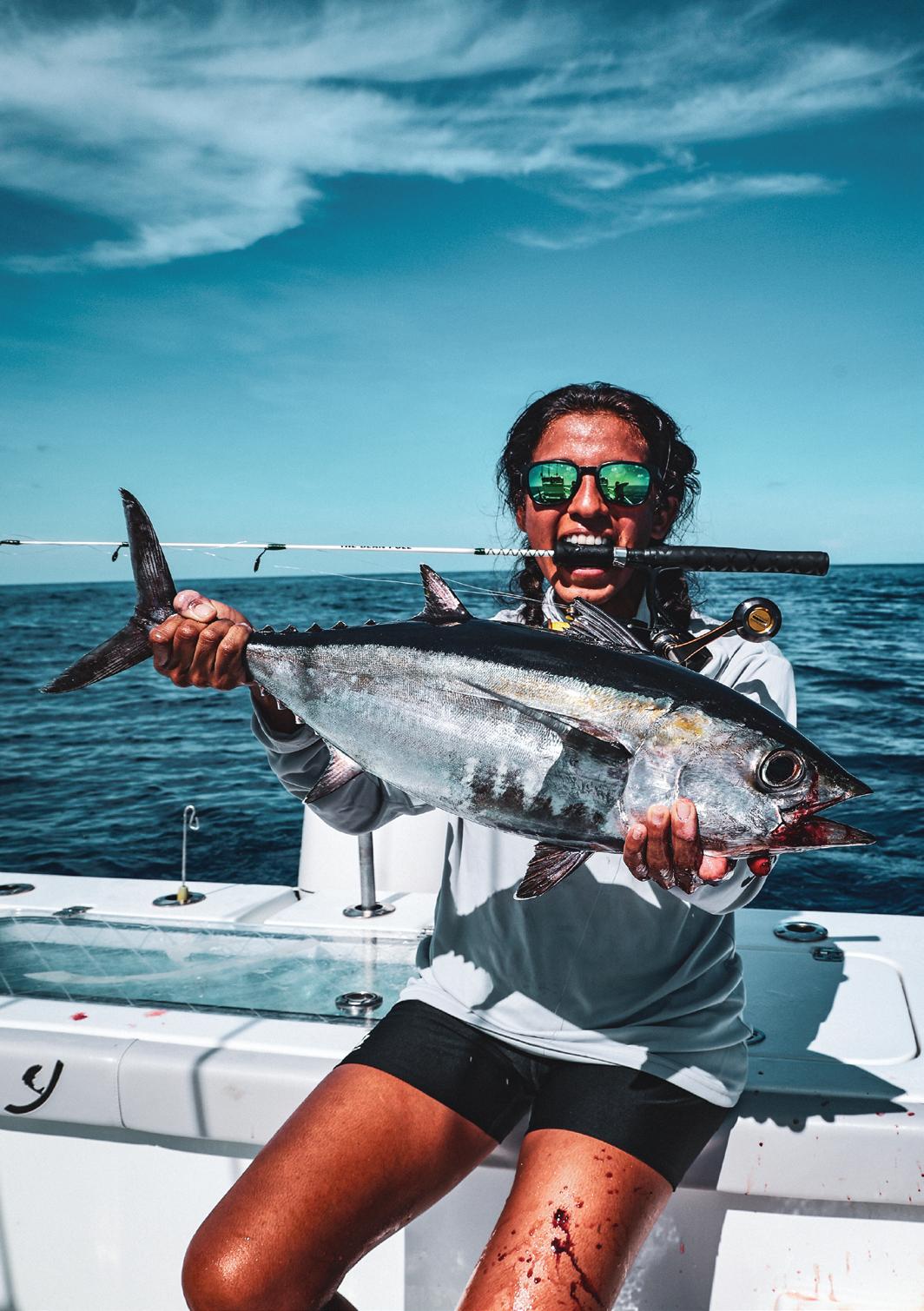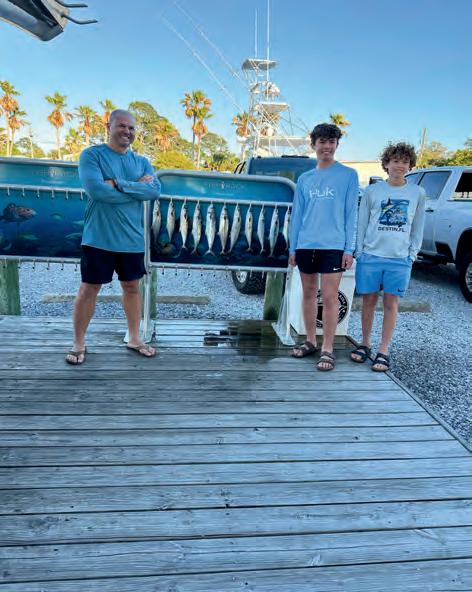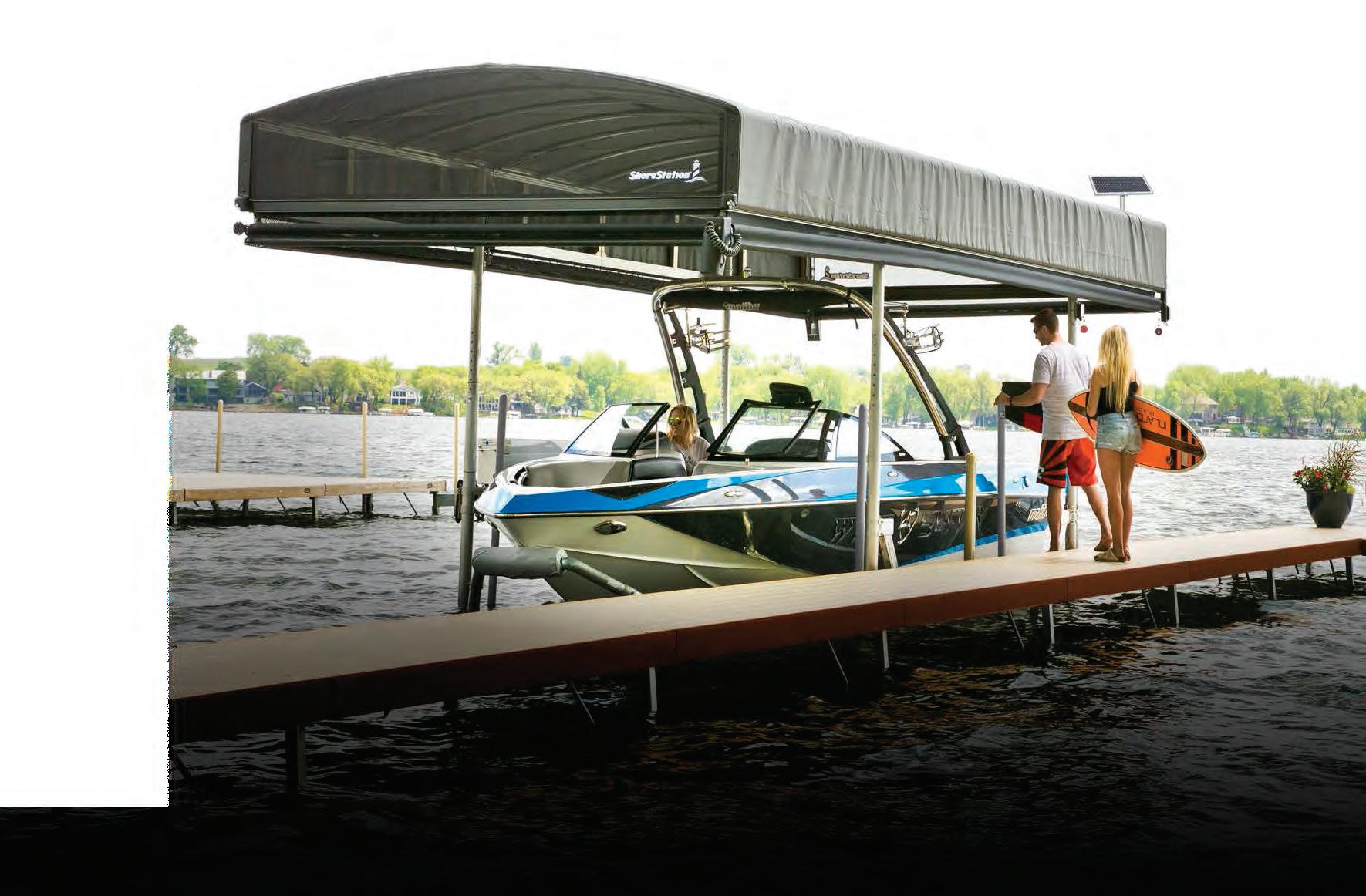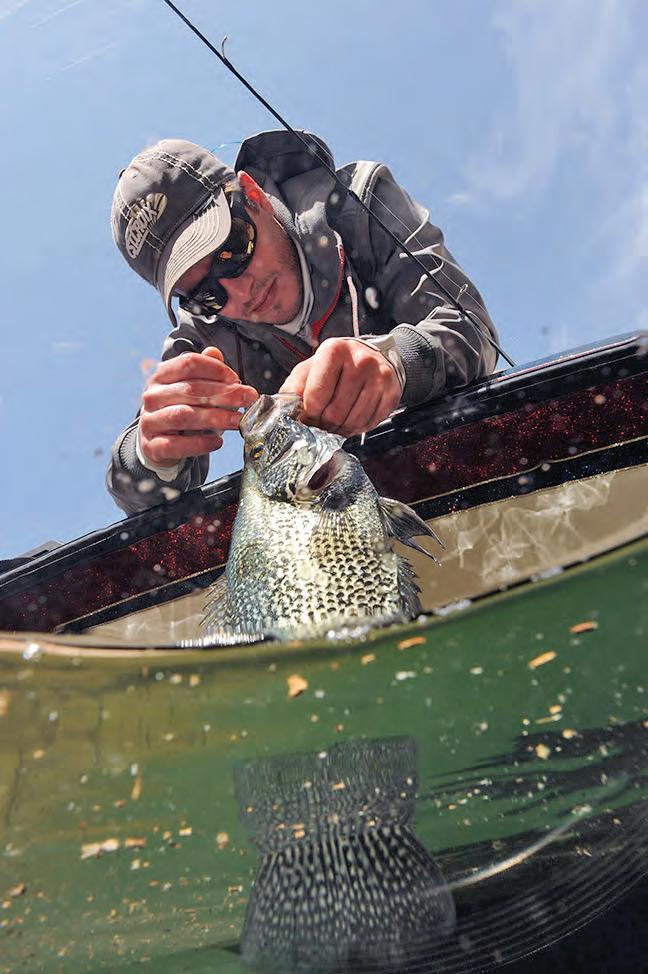









You want new charts?
You got new charts! Explore the ocean with vibrant terrain & depth shading, using all-new TZ MAPS. Don’t just take our word for it. See for yourself. Scan here, and we’ll show you!

Are you ready to embark on your next on-water adventure? Before you set sail, here are fve things to know about boat insurance.
1. Boat insurance isn’t just for accidents
With comprehensive coverage, you’ll also be protected fnancially for theft, vandalism, and unexpected events like storms if you need repairs or replacements due to damage.
2. Accidents can happen to anyone
When accidents happen, boat insurance offers liability coverage for damages or injuries you cause while boating, up to specifed limits. It can also cover lawsuit costs if you’re sued.
3. Boat insurance can cover medical payments
Boat insurance offers a range of optional medical payments coverage limits, helping to cover medical expenses if you’re in an accident or someone is hurt on your boat, regardless of fault.
4. Most lenders require boat insurance
If you fnanced your boat, you’ll likely need boat insurance since most lenders require boat insurance to protect their investment. Additionally, some marinas or municipalities require proof of insurance for docking.
5. Progressive offers specialized boat coverages
Ever worry about getting stuck on the water?
Progressive’s Sign & Glide® On-Water Towing coverage** can help. It’s an additional coverage that steps in if your boat is disabled or breaks down on the water, paying for on-water towing, jump starts, soft ungroundings, and fuel delivery. Fuel cost isn’t included.
Don’t let unforeseen circumstances disrupt your voyage. Cruise with confdence thanks to Progressive Boat insurance. Because when it comes to your boat, peace of mind is the ultimate luxury.
Scan to get a quote in as little as 4 minutes.
to learn more.




















By Skye Burkhardt

In recent years, paddleboard !shing has quietly emerged as one of the most immersive and rewarding ways to !sh, particularly in the backwaters where nature whispers and big !sh lurk in shallow, untouched waters. Combining the stealth of a kayak with the freedom and perspective of stand-up paddling, paddleboard !shing o ers a unique experience that connects anglers to their environment in a deeply personal way. You become part of the environment—just another element in a quiet, dynamic system. Every ripple matters, every shadow could be a !sh. It’s !shing stripped to its essentials: a board, a rod, and your wits.
Backwaters—those slow-moving or stagnant tributaries and tidal creeks separated from larger bodies of water—are havens for !sh and wildlife. ey’re o en shallow, weedy, and di cult to access with motorboats, making them ideal for paddleboards. ese secluded waterways harbor species like red!sh, snook, bass, tarpon, and trout, depending on your region. e calm water allows for sight !shing and careful stalking, while the surrounding vegetation provides natural structure and cover for !sh. For anglers seeking peace, solitude, and the thrill of spotting and targeting !sh in crystal-clear shallows, backwaters are unmatched.
Paddleboards o er several distinct advantages in the backwaters:
• Maneuverability: ey can access shallow and narrow areas where boats can’t go.
• Stealth: Paddleboards glide silently, allowing
you to approach !sh without disturbing them.
• Sight Fishing: Standing gives anglers a better vantage point to see !sh and structure below the surface.
• Portability: Easy to transport and launch, paddleboards can be carried to remote areas with little e ort.
• Minimal Impact: Paddleboards have a low environmental footprint, making them a great choice for conservation-minded anglers.
Fishing from a paddleboard requires packing smart. Space is limited, so prioritize:
• Rod and Reel: A medium-action spinning setup is versatile for most species.
• Tackle Box: A compact, waterproof tackle box with your go-to lures, so plastics, hooks and leaders.
• Anchor or Stakeout Pole: To hold position in wind or current.
• Cooler: Dual-purpose for storage and seating.
• PFD (Personal Flotation Device): Required by law and essential for safety.
• Dry Bag: Keep your phone, wallet, and other valuables safe.
• Sun Protection: Hat, polarized sunglasses, and sunscreen are must-haves.
1. Practice Paddle Control: Master basic paddling and balance techniques before trying to !sh while standing.
2. Stay Organized: Use carabiners and bungee cords to keep gear secure and accessible.
3. Scout the Water: Stand and scan for tailing
!sh, bait activity, or subtle ripples.
4. Be Patient: Quietly dri or pole through likely spots, and avoid sudden movements.
5. Time Your Trip: Early morning and late evening o er cooler temps, calmer water, and more active !sh.
Paddleboard !shing in the backwaters is more than a hobby—it’s a return to simplicity and intimacy with nature. It’s a growing movement that emphasizes low-impact adventure, selfreliance, and a deep appreciation for wild, o en overlooked places. Whether you’re targeting snook in a mangrove tunnel, bass in a hidden freshwater creek, or red!sh on a mud at, the experience of !shing from a paddleboard is less about the catch and more about the connection— to the water, the !sh, and yourself. For anglers ready to trade noise and crowds for silence and solitude, the backwaters await.
If you’re interested in paddleboard !shing, but don’t have the equipment or gear, be sure to enter my “Ultimate Halloween Paddleboard Fishing Package” giveaway presented by Coastal Angler Magazine, where you could score a “Tricked Out” Live Watersports paddleboard equipped with an ePropulsion eLite electric motor, paddleboard !shing gear and accessories, apparel and more! Scan the code in the ad on the next page or visit coastalanglermag.com/CAM-giveaway for more details and to enter.
Find Skye Burkhardt on Facebook at “Inshore Adventures With Skye,” and on Instagram: @brassyangler87.





























Lithium Battery Power (LBP), a leading innovator in advanced battery solutions, has taken top honors in the Energy category at the 2025 International Convention of Allied Sport!shing Trades (ICAST). e company’s groundbreaking Powerbox 2.5 kW / Solar Panel Lithium Battery Charging System was awarded the Best of Category: Energy, signaling a major leap forward in sustainable, high-performance energy technology for anglers and outdoor enthusiasts.
Held annually in Orlando, ICAST is recognized as the world’s largest sport!shing trade show and a hub for innovation within the industry. Each year, hundreds of new products are submitted for consideration across multiple categories, but only the most impressive make it to the winner’s circle. LBP’s Powerbox system stood out for its combination of portability, power, and green energy integration. e award-winning Powerbox 2.5 kW system delivers robust, reliable energy storage and output
in a compact, rugged form factor. It’s designed to meet the demanding needs of outdoor enthusiasts who rely on consistent power in o -grid environments. Integrated with a high-e ciency solar charging panel, the system ensures power sustainability even during extended trips, reducing the need for fuel-powered generators or frequent dock visits.


outages, hurricanes and critical jobsite power along with the heavy 12 volt demands in marine environments got their attention over all others in the Energy category.
“We are honored to receive this recognition at ICAST,” said Don Mitchell, Sales Director for Lithium Battery Power. “Our goal has always been to push the boundaries of battery technology while supporting eco-conscious outdoor recreation. e Powerbox system is a direct response to what today’s anglers need— power that lasts, in a package that’s smart, clean, and easy to use.”
e judges at ICAST praised the Powerbox for its innovative design, versatility, and emphasis on clean energy. Weekend power
is win marks a signi!cant milestone for Lithium Battery Power, reinforcing its position as a leader in the renewable energy sector within recreational vehicle and marine markets.
As the industry shi s toward more sustainable and e cient energy solutions, Lithium Battery Power’s win at ICAST 2025 signals that the future of on-the-water power is not just electric - it’s solar, smart, and built for adventure.

By Will Schmidt
If you have spent any time bottom !shing you know that occasionally on the heaviest of tackle you can outsmart a big snapper and end up with a solid !sh. Other days you can struggle to get even shorts. If you really want to up your game, it is time to lighten up.
When I say light, I mean straight 20 or 30lb mono and light wire 3/0 hooks. You may get broken o at times, but it is worth it for a box full of stud mangos and ARS. My go to big snapper setups is G Loomis IMX Pro Blues 843 casting rod with Shimano Trinadad TN20. is out!t is light, sensitive, and deadly on snapper. Some might like a bit lighter action rod but I have found that even with straight 20lb test you can really put a lot of pressure on these !sh and the backbone is nice to get them o the bottom as quickly as you can. A bit heaver is also nice when that grouper inevitably grabs the bait.
Here is a pro tip. One of the key elements for success to get big snapper, especially mangos, is the ability to react fast. Snapper get their name because they will o en quickly snap at a bait and then release it. With these sensitive rods and a gear ration of 6.2 to 1 you can pick up 46 inches of line in a single turn. A sensitive rod and a fast
reel means when you feel that tap, you can come tight instantly even in deep water. Remember you must use circle hooks so reeling vs setting the hook is the way to connect to these A fast reel might be the most important tool when snapper !shing.
My go to bait is a live pin!sh because, everything eats a pin!sh. I like having a livewell full of nice hand size pins. I do also use thread!ns both live and dead. read are great baits, but a good stout live 7 inch thread is remarkably strong and can be tough to get to the bottom as they swim o with your lead. at means dead threads can be easier to get to the strike zone. Cut the heads and tails o and make a thread “plug.” read “plugs” are awesome for snapper bait especially when live bait is not available. If hook ups are tough, I will double up my hooks, snelling 2 circle hooks close together and getting both hidden inside the plug to increase my hookup ratio. Regardless, I use 3 to 4 feet of mono leader then a swivel and a 3 ounce lead to hold the rig right on the bottom.

light and you will likely !nd the results are worth it.

Whether you really want to target big snapper or the bite is just really tough, try going





By A. deGruchy

Late summer in the Florida Keys means steady black!n tuna action. Look for them around o shore humps like Marathon and Islamorada, especially early in the morning, and over wrecks in 200 to 600 feet of water.
Troll small feathers, ballyhoo, or bonito strips when the !sh are feeding near the surface. If they’re holding deeper, vertical jigging is the way to go. Savage Gear jigs in the 100 to 200 gram range work great. Drop them straight down and work them quickly to trigger bites.
For gear, the new Penn Spin!sher VII combo in the 4500 to 6500 size is a solid choice. Spool it with 30 to 50 pound braid and 30 pound uoro. It’s a strong and smooth setup that handles tuna with ease.
Watch for bird activity like frigates and terns diving. at usually means tuna are pushing bait to the surface. And always !sh with respect. Don’t troll behind another boat or crowd or someone who is already on a school. Give space and enjoy the bite.
Black!n tuna grade is better than blue!n in my opinion; you can eat it raw, do poke bowls, sushi rolls or sear it with sesame seeds!
Be sure to follow deGruchy’s adventures on YouTube (Bean Sport shing TV) and @bean_sport shing on Instagram.





RePower Packages designed to best ft your needs and not stretch your
Financing
Rest assured, all Mastry Suzuki RePowers are backed by Suzuki’s industry leading 5-year factory


Stationed strategically around the East Coast, all Suzuki RePower Centers have achieved the highest level of Suzuki certifcations to meet and exceed your repower needs.
Stationed strategically around the East Coast, all Suzuki RePower Centers have achieved the highest level of Suzuki certifcations to meet and exceed your repower needs.
When Considering A Repower, Consider These Factors:
•Every Authorized Mastry Suzuki RePower Center has decades of repower experience providing proper rigging, controls, propeller matching and in water testing
•With a Mastry Suzuki RePower, owners gain improved performance, less noise and greater reliability
•Mastry Suzuki RePower’s exclusive Owner’s Edge Program*
•Mastry Suzuki RePower Centers use authentic Suzuki OEM parts and have factory certifed technicians

Since 2014, Mastry Engine Center, has been building the premiere Suzuki Outboard repower network in Florida. Today, Authorized Mastry Suzuki Outboard Centers have been exceeding expectaions in the Southeast for over two decades. Recently Suzuki Marine requested Mastry Engine Center to expand the network throughout the Northeast. Now boat owners from Maine to Florida can be assured of the best support for their Suzuki outboard repower project. All Authorized Mastry Suzuki RePower Centers provide the best options, information and package pricing for excellent performance in repower.






*Get with the Program!
When you purchase a new Suzuki outboard from an authorized Mastry RePower Center you qualify to become a member of the Mastry Suzuki Owner’s Edge. Owners receive an identifcation card that provides them with important information about their Suzuki outboard motor as well as a passport to additional benefts during ownership. Members enjoy a detailed engine maintenance schedule, Mastry Suzuki RePower Trade Program and special pricing from Mastry Suzuki Partners

By Capt. Michael Okruhlik
When the end of summer is near and the tides align, there’s no place I’d rather be than Southwest Florida—with a rod in hand and visions of giant snook dancing in my head. !is year, my buddies and I made the pilgrimage with a simple mission: land a personal best. Big sh only. No compromises.


If I had to pick just one, hard twitch baits take the top spot. !ere’s something about that sharp, erratic dart through the water that drives trout wild — and the strikes are violent. Like “wake-up-your-neighbors”, violent. Twitch it, pause it, twitch again — boom! Bonus: many of these lures rattle, which adds an extra layer of appeal in the slightly stained surf water.
When I want a front-row seat to the chaos, I tie on a topwater. Watching a speckled trout explode on a surface lure in the calm surf is pure adrenaline. If it misses, keep working it. Trout in the surf are red up and aggressive — they’ll o en come back for seconds (or thirds). Like the twitch baits, these lures rattle too, which helps draw sh in from a distance.
!e silver spoon has earned its place in Texas shing history, and for good
reason — it still at-out works. I prefer a steady retrieve style spoon for consistent action over a jigging one, but that’s just personal taste. And hey, I’m a paddle-tail guy at heart, so a steady retrieve comes naturally.
So plastics shine in the surf, but go for durability. !ese sh aren’t sitting around like they do in the bay — they’re moving, and fast. !e last thing you want is to waste time swapping lures er every catch.
I use paddle tails with built-in tail rattles and super-loud rattling shrimp. Yes, rattling shrimp exist — and when trout are keyed in on shrimp, nothing else will do. !e realism and noise can turn a slow day into a urry of action.
Live shrimp under a rattling popping cork? !at’s trout candy. It’s simple, e ective, and deadly on calm days.
But if the bite gets nicky, break out the big guns: live croaker. Controversial? Sure. E ective? Absolutely. When the water’s crystal clear and the trout are being picky, croaker can be a day-saver.
Don’t be surprised if a slot red — or even an oversized bruiser — crashes the party. Every lure and bait on this list will get crushed by reds in the surf. Be ready. !e surf might be calm, but your drag won’t be.
Calm surf days are perfect for family shing. Easy wading, plenty of action, and good-sized sh make it a blast for kids and adults alike.
One nal tip: if there’s any southwest wind at all, do what the surfers do on at days — stay in bed. It’ll save you some frustration.
So check that forecast, grab your favorite rattling lure, and remember: always take a kid shing.
Capt. Michael Okruhlik is the inventor of Knockin Tail Lures®, and the owner of www.MyCoastOutdoors.com.




FLORIDA WELCOME CENTER (I-10)
FLORA BAMA
PERDIDO KEY VISITOR INFO CENTER
VILLAGIO PERDIDO TOWN CENTRE
LOST KEY OUTDOORS
JIM’S FIREARMS
WALMART- BLUE ANGEL PKWY
MBT DIVERS
LEGENDARY MARINE PENSACOLA
OUTKAST BAIT & TACKLE
MARINE MAX-PENSACOLA
JOE PATTI’S SEAFOOD
PARADISE MARINE CENTER
NICK’S BOATHOUSE
FISH HOUSE
ACADEMY PENSACOLA
WEST MARINE PENSACOLA
DICK’S SPORTING GOODS PENSACOLA
MIKE’S OUTDOOR SPORTS
GULF BREEZE BAIT & TACKLE
WALMART SUPERCENTER- GULF BREEZE
MEREDITH & SONS LUMBER CO.
HALF HITCH TACKLE
THE SHACK-ORIGINAL WATERFRONT CRAB SHACK
WALMART- NAVARRE
PAT’S BAIT & TACKLE
SOUTH WALTON FLORIDA VISITOR CENTER
GULFARIUM MARINE ADVENTURE PARK
EMERALD COAST BAIT & TACKLE
AJ’S FORT WALTON BEACH
WEST MARINE- FORT WALTON
WILD WILLY’S ADVENTURE ZONE
DESTIN/ FORT WALTON VISITOR CENTER
SUNSET ISLE YACHT CLUB
WEST MARINE- DESTIN
HARBOR WALK MARINA
AJ’S SEAFOOD AND OYSTER BAR
HALF HITCH -DESTIN
WALMART SUPERCENTER-DESTIN
GULF COAST BOATING CENTER
LEGENDARY MARINA- DESTIN
TWO GEORGE’S MARINA
BASS PRO-DESTIN
DESTIN YACHT CLUB
DEWEY DESTIN HARBORSIDE



Ifyou’d told me a few years ago I’d be writing a letter in a fishing magazine I now own… I probably would’ve laughed and gone back to sanding something in the shop. But here we are—and honestly, it’s pretty damn cool.
I grew up in Birmingham, but I’ve spent most of my adult life here on the Gulf Coast. This place has a way of getting into your blood. The people, the pace, the water—it’s a special kind of lifestyle, and one I’m grateful to be part of. Taking over Coastal Angler Magazine felt like a natural fit. It’s more than a magazine—it’s a reflection of this community and the folks who live it every day.
Huge thanks to my fiancée, Chelsea, and my daughter, Demi Ryan. They’re the reason behind everything I do. And to the team that helps bring this issue to life every month, I couldn’t ask for a better crew.
To our readers, thank you for flipping through these pages, supporting local, and being part of what makes the Gulf Coast so great. And to our advertisers—this wouldn’t be possible without you. Your support keeps the lights on and helps us continue sharing the stories, businesses, and passion that fuel this community.
Whether you’re reading this from the dock, the back of your truck, or in your shop on a slow afternoon—I hope it reminds you why we love this place.
Appreciate y’all.
– Dustin Jackson Owner, Coastal Angler Magazine – Florida Emerald Coast

































By: Captain Chris Couvillion
There’s plenty to look forward to this fall on the northern Gulf Coast. Early September promises plenty of action on the Gulf of America, with gag, scamp, and red grouper, red snapper, and triggerfish all available for harvest.
Anglers should come prepared for a fight—especially with gags. Sharp hooks, stout tackle, and strong drags are essential. Chicken rigs tied with #60 line and 3/0–5/0 Mustad Demon Circle hooks are highly productive, whether fished with cut bait or live bait, and will also draw strikes from a variety of other species.
This summer brought consistently good weather, though most of the blue water stayed far offshore from the Emerald Coast. As fall progresses, storms—while sometimes disruptive—can push fish in closer and improve water quality, bringing blue water within reach. This could set up prime opportunities for king mackerel and blackfin tuna to appear nearshore, much to the delight of pier, kayak, and offshore anglers.
Shark fishing continues to be a favorite along the Gulf, with bull sharks, tiger sharks, and several other species providing plenty of action. Look for sharks near artificial reefs, natural rocky bottoms, and ledges, where they put both skill and stamina to the test.
Bait fishing has been excellent all summer at East Pass, with cigar minnows, herring, threadfins, speedos, and hardtails abundant. As cooler fronts arrive in October and November, expect bait schools to linger nearshore around artificial reefs. These same areas will also draw flounder into season; a perfect target for light tackle. A 6 ½-foot rod paired with 20-pound test and a Carolina rig tipped with small live baits is a deadly setup for these tasty slabs.
Offshore, look for things to heat up around the Elbow with white marlin and sailfish hunting bait balls and rips.
October also brings one of Destin’s proudest traditions—the Destin Fishing Rodeo. Running the entire month, this community event draws anglers of every kind: pier, beach, and jetty fishermen, recreational boaters, charters, head boats, paddleboarders, and even overnight divisions. Daily weigh-ins at AJ’s, hosted by longtime weighmaster and entertainer Bruce Cheeves, will showcase impressive catches of bigeye, yellowfin, and blackfin tuna, swordfish, and more. Offshore giants around FADs and oil rigs to the west will provide some of the Rodeo’s most jaw-dropping moments.
When preparation and opportunity meet one can find success!

Since 2014, Captain Chris Couvillion has operated the federally permitted, six-passenger charter vessel Sea Winder. For more information or to book a trip, call (850) 259-9125, email chris@seawinder.com, or find him on Facebook at Charter Boat Sea Winder.



















































































Get in front of 10,000+ outdoor-loving locals and tourists who actually read the ads—because they’re your people.

Build credibility by advertising in a magazine that’s been part of the Gulf Coast community for years. Readers believe what they see here.

Stop waiting on word-ofmouth. Reach high-value customers who are ready to spend—on boats, bait, gear, and everything in between.















































Have Fun Charters Client Caught a Gag Grouper.










It’s no fsh tale when you run with a John Deere. You can get everything done faster and easier, so you get more time on the water. Plus, our special offers make them the catch of the day.








ShoreStation hydraulic boat lifts are a reliable choice for coastal residents and boating enthusiasts alike. Their strong construction, made with corrosion-resistant materials, allows them to withstand harsh environmental conditions, including sun, storms, and saltwater damage. ShoreStation provides a steadfast solution for protecting waterfront investments, o ering peace of mind to owners in the Sunshine State.







Equipped with exceptional weather resistant fabric and breathable SunTex 80 woven mesh ends for maximum protection and durability,

Made from the highest quality materials, our innovative hydraulic boat lift is one of the fastest and safest lifts on the market today. When you have a hydraulic lift, there’s no need to worry about wind and waves getting in your way. This lift will give you con dence to safely land and secure your boat in less-than-ideal conditions.
Never miss another moment on the water. Power your lift with clean, free solar power. Our speedy 20 watt charger features solar regulator drainage protection, saving your battery from permanent damage caused by overcharging.

































An angler from the Midwest recently had a !shing experience to remember along the banks of the Missouri River near St. Louis.
Wally Klein hooked an enormous 86.8-pound blue cat!sh—an incredible catch that tested both his !shing technique and physical strength.

Using gizzard shad as bait and a standard rod-and-reel setup, Klein fought the powerful !sh before !nally bringing it ashore near Washington, Missouri, according to the Missouri Department of Conservation (MDC).
A er snapping a quick photo to commemorate his achievement, Klein released the massive cat!sh back into the river unharmed.

Klein told MDC o cials it was the largest !sh he’s ever caught. e department congratulated him on the impressive feat, saying, “Congrats on this impressive !sh.”
e Missouri River is a well-known destination for trophy cat!sh, particularly blue cat!sh, which are prized for their size and their spirited !ghts—making them a favorite and true challenge among seasoned anglers.
Klein’s cat!sh was a monster, but it didn’t quite break the state record — which was also set in the Missouri River. Back in 2010, Greg Bernal landed a 130-pound blue cat!sh, a catch that was a world record at the time.
Want to learn more about cat shing Missouri’s big rivers?
Visit: https://mdc.mo.gov/ shing/species/cat sh/big-river-cat shing.



Capt. Mike Smith

The common snook, a.k.a. linesider, a.k.a. robalo, is one of the most sought a er game!sh in Florida waters. Sportsmen and women from all over the world come to Florida to catch these hard !ghting, jumping, head shaking, drag pulling !sh.
Snook will de!nitely eat top water lures, jigs, jerkbaits, wake baits, suspending hard baits, spoons, and ies but they love arti!cial shrimp.
Arti!cial shrimp will catch snook all year long; day or night; salt or fresh water; in every ecosystem, anywhere that snook live.
One of the best ways to catch snook with arti!cial shrimp is skipping them under and around structures like mangrove branches, docks, sea walls, sand bars and oyster bars. Pitch the shrimp to the structure and let it sink. en give it a twitch, twitch and let it sink again, then twitch, twitch and repeat the process until your arms get tired of reeling in linesiders..
Snook like a slower retrieve in the cooler months. Make sure to slow it down when the water temperatures approach the 70 degree level or less. A faster retrieve works better when water temperatures are between 75 and 85 degrees. Snook o en stop biting when water temperatures get above 90 degrees.
Another great characteristic of the arti!cial shrimp is that it skips like a dream. e 3 inch shrimp is the go to arti!cial shrimp lure for most hardcore snook !shermen. However, there are days when the snook are more discerning and a 2.75 inch or a larger 4 inch shrimp is the better size and pro!le choice.
e best color choices for shrimp lures are transparent, natural colors with gold or silver glitter in them for sunny days and clear water scenarios. More opaque and darker colors work better in dirty water and on cloudy days.


Many !shermen struggle when !shing arti!cial lures into tight cover scenarios. Sometimes, it takes about 50 casts and the loss of a half dozen shrimp lures to perfect the technique. But it is de!nitely a skill that any serious snook !sherman needs to master.
Capt. Mike Smith, owner of Fish Your Ass O Charters, is an inshore shing guide who has been shing the inshore waters, oyster bars and grass ats of Florida for more than 40 years. Reach him at (561) 339-2317, email: contact@ shyourasso .com or visit shyourasso .com.























Whether for sport or for the table, pan!sh—especially slab crappies and hand-sized bull bluegills—are a favorite target among anglers. And when the air cools and leaves start to fall, pan!sh !shing heats up. Autumn can be one of the best times to catch these !sh, but it comes with a unique set of challenges. Changing vegetation, dropping water temperatures, lake turnover, and bait!sh migrations can make !nding pan!sh feel like solving a seasonal puzzle.
Fortunately, by learning to read these fall cues you’ll consistently !nd success on the water.
As lake temperatures cool and turnover occurs, bait!sh begin shi ing toward shallower cover where they can !nd safety and warmth. is movement sets o a chain reaction. Pan!sh follow the food, o en stacking up around cover like submerged wood or rocky structure. ese areas become prime real estate for fall !shing.
Weather plays a major role, too. On cold, blustery fall days, pan!sh o en slide deeper, becoming more predictable and easier to !nd with electronics. Deep basin areas in 20 to 25 feet of water can light up with schools of crappies—and sometimes bluegills—suspended and ready to bite. ese deeper !sh are o en aggressive, making for a rewarding but ethically sensitive bite. When !shing at those depths, barotrauma becomes a real issue. Released !sh o en don’t survive, even if they swim o , so it’s important to harvest what you catch, regardless of size.
On the ip side, when the weather is mild and
the sun is out, pan!sh can be found shallower, relating to weedlines, cribs, and brush piles. Healthy, vertical weeds are a magnet for fall pan!sh and can hold !sh all the way into !rst ice. In fact, some of the best fall bluegill bites happen in just !ve to eight feet of water, especially in lakes where dense, green weedbeds persist.
Lake size also in uences fall behavior. On smaller lakes—200 acres or less—dropping water temps and decaying weeds tend to concentrate !sh even more. As long as green weeds remain, pan!sh will hold tight to them. But as those weeds die o , the !sh begin to push toward deeper structure or out into the basins in preparation for winter.
Crappies in particular become more predictable in the fall, o en schooling up tighter and acting more aggressively than during other seasons. ey’re easier to pattern as they transition from summer haunts to winter basins, o en stopping along the way at deep weedlines or submerged timber. In lakes with ample wood or crib structure, these can be hotspots that hold large schools well into late fall.

Bluegills, while more opportunistic and scattered, still relate strongly to weed edges and shallow cover when the conditions are right. eir adaptability means they can be caught both shallow and deep, but they may take more searching to !nd than their crappie counterparts.
Despite the variables, the recipe for fall pan!sh
success remains relatively consistent: follow the forage, !nd healthy weeds or cover, and adjust based on the weather. Whether you’re chasing aggressive schools of crappies in deep water or hunting bluegills in shallow weed patches, fall o ers a window of opportunity that savvy anglers won’t want to miss.










Nestled in the heart of the Caribbean, the US Virgin Islands embody a harmonious blend of natural beauty, cultural vibrancy, and laid-back serenity. ese islands are more than just a picturesque getaway; they are a living testament to nature’s rhythm and resilience, e ortlessly in tune with the world around them.
With no passport required for U.S. citizens, from the moment you arrive, the islands’ natural rhythm is palpable. e gentle sway of palm trees, the soothing sound of surf crashing against sandy shores, and the vibrant melodies of local music all echo the heartbeat of this tropical paradise. e islands’ lush landscapes, with their verdant hills and crystal-clear waters, mirror the steady pulse of life that sustains the local ecosystems and communities alike.
e US Virgin Islands’ environment is a symphony of biodiversity with world class !shing and diving. ese natural elements are not static; they dance in harmony, in uenced by the tides, wind, and seasonal changes— further emphasizing the islands’ intrinsic rhythm. is delicate balance underscores the importance of conservation e orts, ensuring that future generations continue to


experience the islands’ natural cadence.


Culturally, the US Virgin Islands are equally in tune. e music, dance and festivals re ect a vibrant heritage rooted in African, European and Caribbean traditions. e spirited calypso beats and reggae rhythms are expressions of life's ongoing dance—celebrating resilience, community and joy. ese cultural expressions are an extension of the islands’ natural rhythm, showcasing how human life here moves seamlessly
with nature’s ow.
In a world o en dictated by chaos and rapid change, the US Virgin Islands serve as a reminder of the beauty of being in sync with nature’s tempo. eir natural, cultural and ecological rhythms o er a blueprint for sustainable living and harmony. As travelers and residents alike continue to embrace this rhythm, they uphold a legacy of balance—one that celebrates life’s natural ow and the enduring spirit of these remarkable islands. In the US Virgin Islands, being in rhythm isn’t just an ideal; it’s a way of life.
Learn more at www.VisitUSVI.com.





Buy One, Get One Free
Valued at over $90,000 MSRP, only 3000 tickets will be sold











Tim Barefoot

September is a peculiar month. Some of the hottest days of the year, hurricane season is in full swing and the !rst northeast winds and cold fronts are about to occur. is is the time of year when wahoo and yellow!n can be caught right up against the beach on big schools of cigar minnows and sardines, or out in the deeper water. ere is no rhyme or reason to it this time of year; these !sh simply follow the bait schools
is is also the time of year when scamp grouper are very vulnerable. If you have the ability to keep a pin!sh trap in the water, it’s a good idea to take live pin!sh with you o shore for a number of reasons. One, pin!sh are very hearty and will live until the end of the day in the live well. Two, they are very sought a er by scamps because scamps view them as egg eaters and will kill them (eat them) so they don’t eat their eggs. And three, they are readily available at all !sh cleaning stations, at most marinas. Yes, I strongly suggest taking two or three boxes of frozen cigar minnows for bait, but live pin!sh are a ringer for scamps and other grouper/ snapper species in the deeper water.
with a cigar minnow. Proof is in the pudding...and here’s your proof. I’ve always said if you !nd the bait you !nd the !sh, and if you !nd big marks of bait (cigs, sardines, tinks, beeliners etc…) you’ll !nd the !sh. It’s always a good thing to have a “spotlight trolling motor” option to be able to sit on the bait or at least slow your dri in currents, but !sh under the bait on or near the bottom for grouper and snappers and keep the light line out for all the pelagics.
Designate one person in the crew to keep multiple light-line baits tended. Do not let this person get complacent and start bottom !shing. e same person should stay focused on the baits and working the Sabiki for whatever bait is below the boat. I’ve always said “Don’t walk in a Chinese restaurant and order a pizza,” meaning whatever is there is what they’re eating! A couple obvious execptions to this is pin!sh on the bottom and greenies/sardines; these baits are universal. We can’t keep gag grouper this time of year or American red snapper, but you can de!nitely !ll the box with other species.

September is when you will see all the tropical species in places you don’t normally see them. All the tropical snappers are everywhere now. Frozen cigar minnows on the Squid Decoy Jig are a wonderful option, but live cigs and sardines are a “whole nother story.” As shown in the photo, the all-time IGFA world record scamp was caught on the 12 ounce

Be ready for that big bite on the light line by choosing your tackle wisely as well. Yes, you need to keep the leader ( oro and wire) size small to get the bites, but use the correct size hooks, reel and line capacity to handle bigger !sh. Like I mentioned earlier, this is the time of year when wahoo are everywhere...and nowhere. You could catch a giant wahoo or tuna inshore, or in the deep water, just be prepared for it and be ready to chase it down if need be. e kite is always a great option if you have the team that can y the kite and bottom !sh simultaneously as it can be a challenge with wind speed, direction and current.
Learn more from Tim Barefoot on his YouTube channel and at barefootcatsandtackle.com.



















